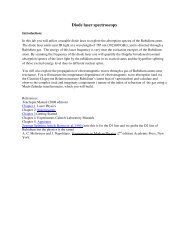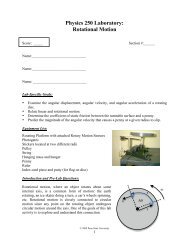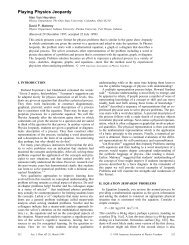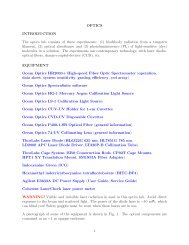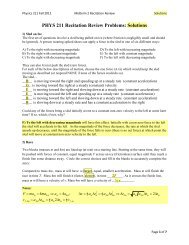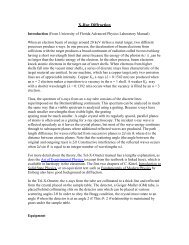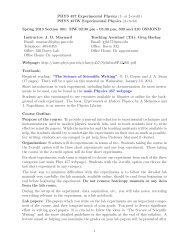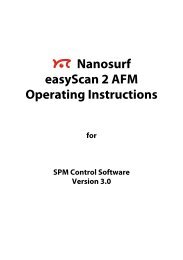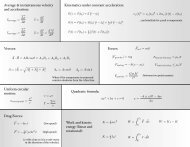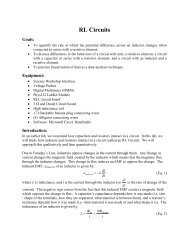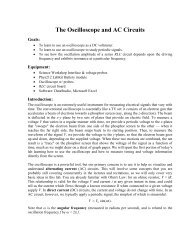Static Electricity (Lab 01)
Static Electricity (Lab 01)
Static Electricity (Lab 01)
You also want an ePaper? Increase the reach of your titles
YUMPU automatically turns print PDFs into web optimized ePapers that Google loves.
lock<br />
When the block is at this position (which we will call X<br />
0<br />
), we know that the block-mounted<br />
ball will be at position x 1 = −d (i.e., its center of mass will be one ball-diameter away from the<br />
center of mass of the suspended ball).<br />
4. With the block-mounted ball just barely touching the suspended ball, record the position of<br />
the block:<br />
“Zero” position of the block (<br />
block<br />
X<br />
0<br />
): ___________________________<br />
If we move the block farther to the left, the block-mounted ball’s position with respect to our<br />
origin will become more negative. If we move the block farther to the right, the ball’s position<br />
will become more positive. Using these notions, we can write down an expression for the blockmounted<br />
ball’s center-of-mass position (x 1 ) as a function of the block’s position measured via the<br />
block<br />
measuring tape ( X ) as<br />
block block<br />
x (<br />
X X ) . (Eq. 4)<br />
1 0<br />
d<br />
You should verify for yourself that this expression satisfies the conditions we just described. To<br />
summarize: we will record the block-mounted ball’s position by measuring the position of the<br />
block itself via the measuring tape provided on the outside of the apparatus.<br />
How do we determine the suspended ball’s position? At the back of the Coulomb’s law<br />
apparatus, a separate ruler is mounted below a mirror. If you try to line up the ball with the ruler<br />
at the back of the apparatus, you’ll notice that you can get drastically different position readings<br />
if you move your head left or right. This phenomenon is called parallax, and occurs anytime you<br />
try to compare the transverse positions of objects located different distances away from you. To<br />
help minimize the effect of the parallax, we can try to line up the edge of the ball directly with its<br />
reflection in the mirror. When we do this, we’re looking dead-on at the edge of the ball, and can<br />
trust our reading from the ruler at the back of the apparatus.<br />
So, to find the position of the suspended ball at any point in time, we just line up the edge of the<br />
ball with its reflection in the mirror, and look to see where this lines up with the ruler. This<br />
mirror<br />
position we can call X . When the ball is hanging straight down, we’ll say that its edge is at<br />
mirror<br />
position X<br />
0<br />
(which corresponds to the center of mass being at a position of x 2 = 0). From<br />
these considerations then, we find that the suspended sphere’s center-of-mass position (x 2 ) can be<br />
determined from the measurement with respect to the ruler at the back of the apparatus by<br />
mirror mirror<br />
x X . (Eq. 5)<br />
2<br />
X<br />
0<br />
5. Record the “zero” position of the edge of the suspended ball when it hangs vertically<br />
downward, as measured with the no-parallax method described above with respect to the<br />
ruler in the back of the apparatus.<br />
“Zero” position of edge of the suspended ball (<br />
mirror<br />
X<br />
0<br />
): ___________________________



